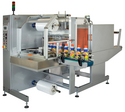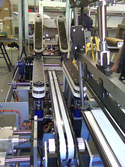Delivering the goods
18 June 2009Where would the FMCG supply chain be without films that can stretch or shrink to order? Sam Cole surveys the latest developments in transit and presentation packaging technology
Never has so much been achieved by so little. Whether it’s stretching itself around a full pallet load to three times its inert dimensions or else shrinking down by 30 per cent to contain a multi-pack of Coke cans, polymer film technology is equally adept at meeting the challenge – and at the same time manifestly proving the point that less really can be more in terms of fitness for purpose.
While shrinkwrap and stretch film are likely to be employed for the same bill of goods, their usage is entirely different. Shrinkwrap is an ever-present commodity on supermarket shelves, increasingly overprinted in up to eight or even 10 colours; the closest that most stretch film will be exposed to consumer scrutiny post its original application as protective transit packaging will probably be in its recycled state as a bin liner or a garden chair.
BPI Films is arguably the UK’s largest supplier, with differing grades of both shrink (polyolefin) and stretch (predominantly PE) comprising a significant proportion of the 100,000 tonne of film shipped per annum to packer/fillers and converters. The chemistry has added value and versatility to each format, but the overriding benefit being brought to the market is reduced material usage to raise performance standards.
“Our best selling stretch film is RM Supreme, a 17 micron thickness grade that extends by 250 per cent and can be co-extruded in up to five layers using the latest metallocene polymer technology,” says sales director Alex Begley. “Whilst that entails machine processing, at the other end of the scale we also supply a manual wrap grade – Wrapsmartultra – down to as low as 7 micron thickness.”
Another plus point from a retailer perspective is recyclability, says PAFA chief executive David Tyson: “With no contaminants, stretch film is a very clean material to pass on for recovery and to be sold on for PRNs. That’s a highly attractive end of life proposition.”
Effectively closing the loop, BPI maintains its own recycling division, which recovers an annual 80,000 tonne of mixed waste plastics – ‘jazz’, as it’s known in the trade, due to its’ multi-coloured composition prior to its re-emergence as black bin liners et al.
Dual functionality
While 99 per cent of all stretch film is destined for a life on the road, shrinkwrap applications are equally divided between transit and presentation – with a promotional focus on the latter generating an accelerating demand for pre-printed material for on-shelf multi-packs.
“Growth in the printed collation sector is running at about 20 per cent/year, albeit from a relatively low base,” says BPI’s shrinkwrap specialist Mike Thackwray. “Treated shrinkwrap is now directly competing with cartonboard, against which it offers something like a 6:1 weight saving as well as reductions in energy consumption and manufacturing cost. I know of at least two UK brewers that are switching out of board over the next few months.” BPI’s response is Nov8: a high performance low-density polyethylene film flexo printed (on a Comexi press) in up to eight colours, and currently “selling in thousands of tonnes”.
Not that BPI is dragging its heels on the staple shrinkwrap side of things, either, says Mike Thackwray. “We have a major development on-going with the machinery manufacturer KHS Kister, looking to reduce current average thickness down to 25 micron and still achieve the same throughput. Early trials have achieved 90 units/min, which would be typical of a 35 micron film. The lesser the micron thickness, of course, the more units outputted per tonne; and the thinner the film, the faster the speed.”
Required rate of production is the principal factor determining the level of investment in what is a highly competitive shrinkwrapping machinery sector that operates at anything from 20-120 packs/min. The upper end wouldn’t be possible without servo technology, which in some cases has closed the door to realising part-exchange or second-hand value for converters planning to upgrade, says Friedheim International MD Peter Morris.
“Apart from going faster there’s not much more innovation that can be put into these systems; the principles are and always have been the same. Having upgraded, if converters were to put them out into the market then someone in a lower cost labour environment would find a way of wrapping products cheaper. Basically, they put a hammer through them.”
Like most suppliers, Friedheim covers the entire gamut. “Our main thrust is with Beck Packatomaten, a key feature of whose technology is the capability to sense the dimensions of different individual products coming down the line and wrap them accordingly. We must have installed over 200 systems (single-lane) within the UK. They can get up to 120 packs/min (single-lane), are servo-driven, and priced between u34,500-u172,500, dependent upon what you want the machine to do and how clever you need it to be.”
At the other end of the scale is the Audrion: “Ideal for customers not looking to spend u15,000 upwards, and as a point of entry or single order application-specific option, whose speed is as quick as you can feed it,” says Peter Morris.
Ocme’s Vega shrinkwrappers are also capable of outputting 120 packs/min, and while custom-built to order, certain components are common to all models with a top of the range three-lane system costing as much as u500,000. With speed pretty much at the max, Ocme is now looking at other production innovations, says sales manager Peter Mayhew.
“We have a technique with the tunnel, which allows us to inflate the pack slightly before it contracts to get closer to a wrinkle-free finish on-pack. We’ve also been able to cut energy cost incurred within the tunnel by 30 per cent. Next on the agenda is a faster change-over system that we’ll be introducing at the US Interbev show in October.”
Servo-driven machines can double the speed yet increase the cost by only 20 per cent of the pneumatically controlled models they’re steadily replacing, says Linkx Systems technical director David Hayward. The company’s first Matrix shrinkwrapper has just been installed at the Bird’s Eye plant in Lowestoft, running at 300 cartons/min (three-lane) to realise a 50 per cent increase in productivity. Additionally, Linkx can retrofit the same servo technology and touch of a button change-over facility onto existing Europack machines, of which Hayward estimates there must be at least 40 currently in operation throughout the UK.
Speed isn’t the only issue, says Adpack MD John Farrow, most of whose Italian and German (BMV) imported single-lane systems are outputting at between 35-100 packs/min. “Reducing manpower is also key. Automating collation of the product as well as wrapping enables operators to be more efficiently redeployed.”
In these strapped for cash times, some companies might be forgiven for supposing that cost of investment is the only thing that really counts. Better housekeeping might help to stave off the need to re-equip, he says. “A life expectancy of between 10–15 years would be reasonable for a servo-driven shrinkwrapper; yet we’ve replaced machines that are only five years old but have been sweated to death by the customer. That’s why we like to link into service contracts so that we can support the customer throughout.”
“One option that we’re happy to work with is to lease,’ says Kern national sales manager Tony Bradley. “In one recent case, the cost justification stacked up to achieve payback in less than 12 months, quickly identifying that the investment would be covered by cost savings alone, making a profit by the end of the year. As an example, a customer who needs to invest £100,000 may prefer to use his cash for stock, maintaining good cash-flow. At typical lease rates we could pull a deal together for less than £500 per week, a figure that can be quickly cost justified by the customer who knows his expected savings and pay-back.’
Viable alternative
With especial reference to the use of shrinkwrap within the presentation sector, Marden Edwards MD Jeremy Marden is adamant that overwrapping can sometimes represent a more cost-efficient and attractive option.
“Basically, our systems wrap film around the pack using a cut and fold technique to create a diamond-point end-fold; that’s then sealed down along the side of the pack,” he explains. “To ensure absolute tightness, the process uses little dabs of heat – around 2 kw compared with the 20 kw within a shrink tunnel, where temperatures can reach 200 degC – to seal the end and the underneath. Because you no longer require small perforations in the film for heat to escape, it’s ideal for products where you want to guarantee against aroma migration, for example tea and tobacco.”
Entry-level machines start at around u28,750. Outputting speeds are comparable: on average 100 packs/min, but for certain applications three times that. Without the need for a shrink property, companies have the option to work with a less expensive film than polyolefin. Once considered a relatively cumbersome process, most overwrapping systems will now facilitate fast change-over. Another advantage over shrink is that overwrap can incorporate an easy-open tear-tab. It’s not however, a universal panacea. The obvious caveat is that the process is limited to at least a roughly rectilinear pack dimension.
Ocme Vega shrinkwrapping 120 packs/min Kern's Generic sleeve wrapper All drives on the Linkx Matrix are servo controlled




